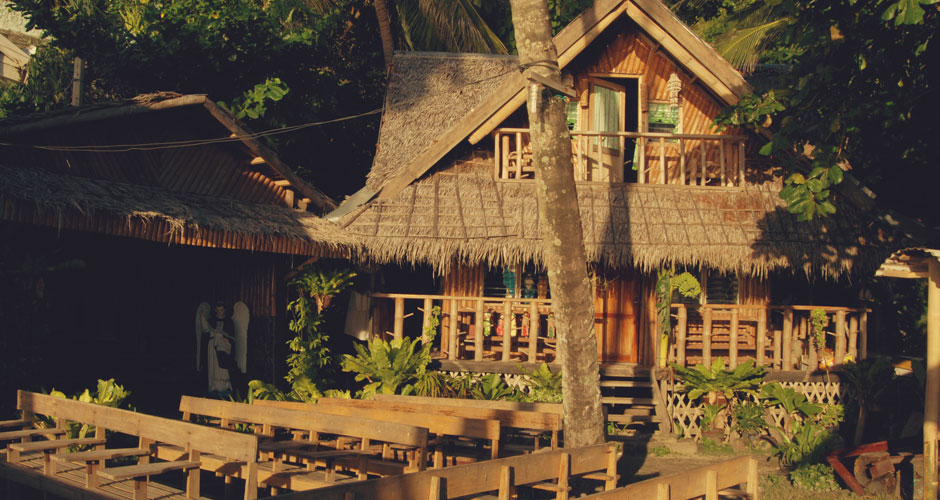The boat standing before me is not quite what I expected for my 30-minute trip from The Philippines island of Negros Oriental to the tiny road-free community of Apo Island (population: 800). Based on my previous sojourns to tropical islands, I’d envisaged a vessel for 10 or so passengers, with – at the very least – an edge to grip onto. Instead, the boat that laps at the shore in front of me is a narrow wooden seacraft with space enough for me, the captain and the ‘first mate’, who is using a handheld oar for a rudder. I remove my sandals and wade into the water, clambering aboard the nose of the boat in an unladylike manner.
As the engine comes to life and we edge out to sea, a light spray splashes across the boat, providing a refreshing repose from the sharp pinch of the sun. I soon learn that this is only the beginning, and as our course leads us into the path of oncoming waves, I am quickly saturated from head to toe. While my two sea-faring companions are at my back, I sense that they are finding the whole situation highly amusing, and I can’t help but laugh at my resemblance to a drowned rat.
My water-logged state is soon forgotten as the beaches of Apo Island come into view. Its lush, undulating landscape dotted with thatched-roof shacks seems to beckon me to its shores. I am staying at Liberty’s Resort, a quaint set of lodgings built into the hill just off the beach of Apo’s shoreline. Since opening the resort in 1996, owners Liberty and Paul have used the profits from the hotel and their dive shop to support the local Apo community and the island’s ecosystem.
I have braced myself for rudimentary dwellings based on what I have read, but when I push open the door to my room, I am in awe. It is simple in nature – exposed stone walls, tiled floors and a very basic bathroom – but the bamboo four-poster bed, draped in a sky-blue mosquito net, is particularly inviting. The true jewel of these quarters lies beyond the doors to the balcony, which boasts the most beautiful view I’ve ever had the pleasure of waking up to. Towering palm trees frame the picture-perfect vista: a white sandy beach, aquamarine waters and a view to the horizon. With a western-facing outlook, I am assured of a spectacular sunset.
After a few moments indulging in the view, I head down to the beach to go snorkelling. The water is perfectly temperate, even a little too warm in the shallows, and the marine community that dwells beneath its surface is a melange of colourful residents. Fish of shimmering blues, greens and purples dart around the coral, going about their business. The locals have told me that this time of day is perfect for encountering turtles, but after 20 minutes in the water, I am yet to meet one. I keep my eyes peeled, peering under rocks and in coral beds, but with still no luck I float, motionless, for a few seconds. I soon get the feeling I’m being watched and I look slowly to my left, only to see two turtles staring curiously in my direction. Their sheer size makes me realise sheepishly that there was no chance of finding them under the rocks I had been keenly surveying. I spend the afternoon following the creatures around as they move gracefully through the water, almost as if they’re giving me a personal tour.
Having bid the turtles farewell, I spend the late afternoon exploring the local village. It’s humbling to witness the simplicity of living within the Apo community. The village is composed mostly of basic structures made from bamboo, driftwood and palm leaves, with the odd cement building such as the modest church that lies just off the beach. I make my way along the sole paved path in the village, which winds amongst the shacks. Locals bid me hello with sunny smiles and murmur to each other about the stranger in their midst. As I walk deeper into the village, a little girl takes my hand and leads me along the path, while her two brothers run circles around us playing their own imaginary game. Soon a few dogs join our group, followed by a goat and a rooster, making me feel like the Pied Piper. After a tour of the village, I return the kids in the direction of their home, and the little girl waves me a glum farewell.
As the sun edges towards the horizon, lighting the water a warm shade of peach, the aural tranquillity of the island is abruptly broken by the rhythmic crash of drums. I follow the sounds through the snaking narrow path. When I come to a stop between two little shacks that frame a golden stream of sunset, a kind-eyed old women nods towards the gap encouragingly. Squinting, I walk into the fading sunlight, where I glimpse silhouettes on the beach, all moving to the same rhythm. A group of young guys with various percussion instruments pound out a hip-shaking beat with enthusiasm, while local kids dance gleefully, letting the rhythm enrapture their tiny bodies as they laugh uncontrollably.
Their laughter stays with me as I wander back to the resort to catch the last of the sunset from my balcony. While the people of Apo Island live on virtually nothing, housed in the most basic of dwellings, I feel a tinge of envy for them. With days filled with laughter, dancing, and a stalwart sense of community surrounded by the simplicity of nature, their existence seems to combine the key ingredients to a life well-lived.



